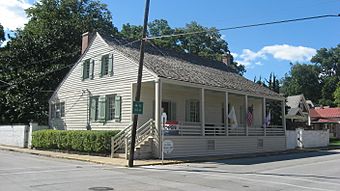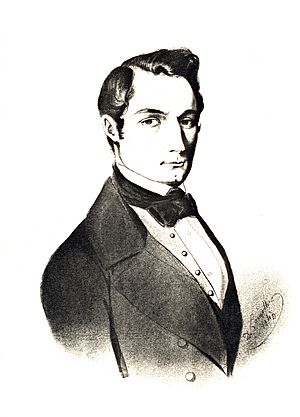Jacques Guibourd Historic House facts for kids
|
Jacques Dubreuil Guibourd House
|
|
|
U.S. National Historic Landmark District
Contributing Property |
|

Front and side of the house
|
|
| Location | Northwestern corner of 4th and Merchant Sts., Ste. Genevieve, Missouri |
|---|---|
| Built | 1800 |
| Architectural style | French Colonial |
| Part of | Ste. Genevieve Historic District (ID66000892) |
| NRHP reference No. | 69000307 |
Quick facts for kids Significant dates |
|
| Added to NRHP | May 21, 1969 |
| Designated NHLDCP | October 9, 1960 |
The Guibourd House, also known as La Maison de Guibourd, is a special old house in Ste. Genevieve, Missouri. It was built around 1806 and was the home of Jacques Jean Rene Guibourd and his family.
This house is built in a unique style called poteaux-sur-solle. This means it has strong vertical wooden posts set on a foundation. The spaces between the posts were filled with a mixture called bouzillage, usually made of clay and grass.
The Guibourd House looks a lot like other French-style homes from that time. These homes were common in areas where French people settled, like the Illinois Country, eastern Canada, and the Louisiana territory.
Over the years, the house has changed a little to fit the families who lived there. But it still looks much like it did in the early 1800s. It used to have wide porches, called 'galleries', all around it. These porches helped keep the inside of the house cool in summer and protected it from snow in winter.
A few years after the main house was built, a separate kitchen building was added. This kitchen was made of brick and was not attached to the main house. This was done to keep the main house cooler in summer, to keep cooking smoke out, and because the French thought the smell of cooking inside was unpleasant. It was not mainly because of fire danger, as some people think.
The Guibourd kitchen was built partly under one corner of the porch. This made it easy for the family and their enslaved people to serve hot, dry meals on time. The Guibourd House is one of the few places in Ste. Genevieve that still has its original kitchen and enslaved people's quarters from this time.
The Guibourd House is an important part of the Ste. Genevieve Historic District. This district is recognized as a National Historic Landmark. Today, the house is a historic house museum where visitors can learn about its history. It is managed by the Foundation for Restoration of Ste. Genevieve, Inc.
Contents
Jacques Jean-René Guibourd: A Life Story
Jacques Jean-René Guibourd de Luzinais was born on July 29, 1755, in Candé, France. His parents were Christopher Ambroise Guibourd and Renée Maguerite Gibault.
He married Ursule (Ursula) Barbeau on June 24, 1800. Ursula was the sister-in-law of Jean-Baptiste Valle, an important person in Ste. Genevieve. Jacques and Ursula had five children, all born in Ste. Genevieve:
- Eugene Jacques Pierre Guibourd (born 1801, died 1879)
- An infant who died in 1803
- Jean Edward Guibourd (died 1805)
- Omer François Guibourd (born 1807, died 1874 in France)
- Jules Joseph Marie Guibourd (born 1811, died in France)
Jacques Guibourd passed away on May 29, 1812, in Ste. Genevieve, Missouri. He was buried in the Ste. Genevieve Memorial Cemetery.
Journey to Ste. Genevieve
Jacques Guibourd's journey to Ste. Genevieve was quite an adventure. He first left France for Saint Domingue (now Haiti), where he worked as a secretary for a rich plantation owner. During a slave rebellion there, his enslaved person, Moros, helped him escape by hiding him in a cargo barrel.
Jacques and Moros then traveled back to France. However, France was in chaos because of the Reign of Terror (1793–94), which happened after the French Revolution. Seeing the destruction, they decided to leave their homeland again. They heard about French-speaking settlers in America and decided to sail there.
It's believed that Jacques and Moros were shipwrecked during their voyage and lost everything they owned. When Jacques arrived in Ste. Genevieve, Missouri in the late 1790s, he had no money.
Ursula's father, Jean-Baptiste Barbeau, took Jacques (and likely Moros) in until he could get settled. This is how Jacques met his future wife, Ursula. He also became friends with Jean-Baptiste Valle, who was the Commandant (leader) of Ste. Genevieve at the time.
In 1799, Jacques received a Spanish land grant for the entire block where his house now stands. While his house was being built, Jacques opened a store across the street. He sold goods to the villagers. His old records show what he sold, to whom, how much it cost, and how people paid.
After marrying Ursula in June 1800, Jacques quickly became involved in town life. He served as a judge and helped manage taxes for the Ste. Genevieve District. He was also one of the first leaders of the 1808 Ste. Genevieve Louisiana Academy. This was the first school for higher education west of the Mississippi River.
Besides being a merchant, Jacques owned a tannery (a place where animal hides are made into leather) a few miles south of town. He also owned a lead mine west of town in what is now Washington County, MO.
Jacques' son, Eugene, married Marie Therese St. Gemme Beauvais. They had 12 children, most of whom were born in Old Mines, Washington County, MO.
After Jacques died in 1812, and Ursula died in 1843, their sons Jules and Omer inherited the southern half of the property and the house. Their son Eugene, who had moved back to Ste. Genevieve in 1839, inherited the northern half.
Eugene's son, Felix, traveled to France with his uncles Jules and Omer when he was 11. He studied science and art and went to medical school in Paris. Felix returned to Ste. Genevieve in 1865 and worked as a doctor until he passed away in 1885.
In 1859, Jules and Omer sold their part of the property to Eugene. Later, it became the property of Felix. In 1907, the property was sold to Clovis G. Boyer, who then sold it to Jules Felix and Anne Marie Vallé. In January 1973, Anne Marie's will left the house to the Foundation for Restoration of Ste. Genevieve.
Images for kids
See also
- Louisiana (New France)
- Louisiana Purchase
- Illinois Country
- Ohio Country
- New France
- New Spain
- French in the United States
- Timeline of New France history
- Three Flags Day
- A few acres of snow
- French colonization of the Americas
- French colonial empire
- List of North American cities founded in chronological order
- Sainte Geneviève
- List of commandants of the Illinois Country
- Historic regions of the United States





